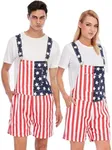Buying Guide for the Best Insulated Coveralls
When it comes to choosing the right insulated coveralls, it's important to consider several key factors to ensure you get the best fit for your needs. Insulated coveralls are designed to keep you warm and protected in cold environments, making them essential for outdoor work or activities in chilly weather. By understanding the key specifications, you can make an informed decision and select the coveralls that will provide the comfort, warmth, and durability you require.Insulation MaterialInsulation material is what keeps you warm in cold conditions. Common materials include synthetic fibers like polyester or natural down. Synthetic insulation is often more affordable, dries quickly, and retains warmth even when wet. Down insulation is lightweight and highly effective at trapping heat but can lose its insulating properties when wet. Choose synthetic insulation if you expect wet conditions or need a budget-friendly option, and opt for down if you need maximum warmth and are confident you can keep the coveralls dry.
Outer Shell MaterialThe outer shell material of insulated coveralls affects their durability and weather resistance. Common materials include nylon, polyester, and cotton blends. Nylon and polyester are typically more water-resistant and durable, making them suitable for harsh weather and rugged use. Cotton blends may offer more comfort and breathability but are less resistant to moisture. If you work in wet or rough conditions, choose coveralls with a nylon or polyester shell. For lighter use or more comfort, a cotton blend may be sufficient.
Fit and MobilityFit and mobility are crucial for comfort and functionality. Insulated coveralls should provide enough room for layering underneath without being too bulky. Look for features like gusseted crotches, articulated knees, and adjustable waistbands to enhance mobility. If you need to move freely and perform physical tasks, prioritize coveralls with these design features. For less active use, a standard fit may be adequate.
Temperature RatingTemperature rating indicates the range of temperatures in which the coveralls will keep you warm. This rating can vary widely, so it's important to match it to the conditions you'll be facing. For extremely cold environments, look for coveralls with a lower temperature rating. For milder conditions, a higher temperature rating will suffice. Consider the coldest temperatures you expect to encounter and choose coveralls rated for those conditions to ensure you stay warm.
Water ResistanceWater resistance is important if you'll be exposed to wet conditions. Some insulated coveralls come with water-resistant or waterproof coatings to keep you dry. Water resistance is typically measured by the material's ability to repel water and prevent it from soaking through. If you work in rainy or snowy environments, prioritize coveralls with high water resistance. For dry conditions, this feature may be less critical.
BreathabilityBreathability refers to the coveralls' ability to allow moisture and sweat to escape, preventing you from feeling clammy. This is especially important if you'll be active while wearing the coveralls. Materials like Gore-Tex or other breathable fabrics can help regulate your body temperature by allowing moisture to escape while keeping warmth in. If you expect to be physically active, choose coveralls with good breathability. For less strenuous activities, breathability may be less of a concern.
DurabilityDurability is a measure of how well the coveralls can withstand wear and tear. Reinforced stitching, heavy-duty zippers, and durable materials contribute to the longevity of the coveralls. If you work in a demanding environment where the coveralls will be subjected to rough use, prioritize durability. For lighter use, standard construction may be sufficient.
Pockets and StoragePockets and storage options are important for carrying tools and personal items. Insulated coveralls often come with multiple pockets, including chest, hand, and interior pockets. Consider the type and number of pockets you need based on what you typically carry. If you need to keep tools or other items handy, look for coveralls with ample and well-placed pockets. For minimal storage needs, fewer pockets may be adequate.























